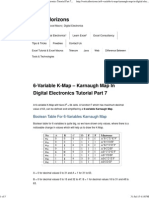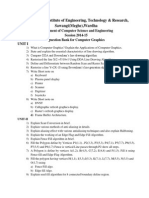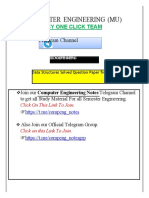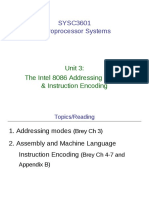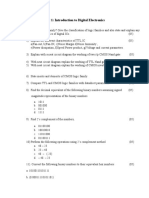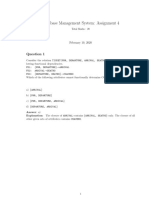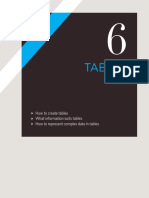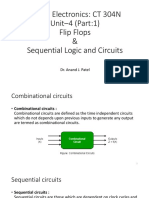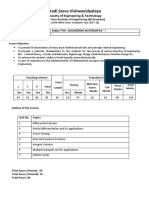Assignment-1: Digital Electronics: CT 304-N Semester: 3 (CE/CSE/IT)
Uploaded by
Liyanshu patelAssignment-1: Digital Electronics: CT 304-N Semester: 3 (CE/CSE/IT)
Uploaded by
Liyanshu patelDigital Electronics: CT 304-N
Semester: 3 (CE/CSE/IT)
Assignment-1
Chapter-1 Number Systems and Codes
No. Questions
1. Write the first 20 decimal digits in base 3.
2. Convert the decimal number 250.5 to Base 3, Base 4, Base 7, Base 8, Base 16
3. Convert the following decimal numbers to binary
1. 12.0625 2. 104 3. 673.23 4. 1998
4. Convert the following binary numbers to decimal
1. 10.10001 2. 101110.0101 3. 1110101.110 4. 1101101.111
5. Convert the following numbers from the given base to the bases indicated.
a) decimal 225.225 to binary, octal and hexadecimal
b) binary 11010111.110 to decimal, octal and hexadecimal
c) octal 623.77 to decimal, binary and hexadecimal
d) Hexadecimal 2AC5.D to decimal, octal and binary
6. Convert the following numbers to decimal
a) (1001001.011)2 e) (0.342)6
b) (12121)3 f) (50)7
c) (1032.2)4 g) (8.3)9
d) (4310)5 h) (198)12
7. Obtain 1’s and 2’s complement of the following binary numbers
1010101, 0111000, 0000001, 10000, 00000.
8. Obtain 9’s and 10’s complement of the following binary numbers
13579, 09900, 90090, 10000, 00000.
9. Perform the subtraction with the following decimal numbers using 1.10’s and 2.
9’s complement
a) 5250-321 b) 3570-2100
c) 753-864 d) 20-1000
10. Perform the subtraction with the following binary numbers using 1.2’s and 2. 1’s
complement
a) 11010-1101 b) 11010-10000
c) 10010-10011 d) 100-110000
11. Represent the decimal number 8620
a) BCD
b) Excess-3 code
c) 2, 4, 2, 1
d) Binary number
12. Express the following switching circuit in binary logic notation.
You might also like
- Digital Logic Design: Assignment 1 Due Date: 10.12.2020 (Thursday)No ratings yetDigital Logic Design: Assignment 1 Due Date: 10.12.2020 (Thursday)3 pages
- ENGN 3226 Digital Communications Problem Set #8 Block Codes: Australian National University Department of EngineeringNo ratings yetENGN 3226 Digital Communications Problem Set #8 Block Codes: Australian National University Department of Engineering13 pages
- Vertical Horizons: 6-Variable K-Map - Karnaugh Map in Digital Electronics Tutorial Part 7No ratings yetVertical Horizons: 6-Variable K-Map - Karnaugh Map in Digital Electronics Tutorial Part 75 pages
- Shivajees MCQ On Microprocessor (Instruction Set) - GATENo ratings yetShivajees MCQ On Microprocessor (Instruction Set) - GATE13 pages
- AP PGECET CS and IT (CS-2015) Question Paper & Answer Key. Download All Previous Years Computer Science & Information Technology Sample & Model Question Papers.100% (2)AP PGECET CS and IT (CS-2015) Question Paper & Answer Key. Download All Previous Years Computer Science & Information Technology Sample & Model Question Papers.16 pages
- Information Theory and Coding SEE QP 2021-22No ratings yetInformation Theory and Coding SEE QP 2021-227 pages
- Digital Electronics & Fundamentals of Microprocessor Paper - IV100% (1)Digital Electronics & Fundamentals of Microprocessor Paper - IV2 pages
- BBEE203 Module 4 Boolean Algebra and Logic CircuitsNo ratings yetBBEE203 Module 4 Boolean Algebra and Logic Circuits19 pages
- Chapter Two (Part 2) Data Link Layer Protocols (Q & A)No ratings yetChapter Two (Part 2) Data Link Layer Protocols (Q & A)14 pages
- Digital Design-Digital Electronics Question BankNo ratings yetDigital Design-Digital Electronics Question Bank1 page
- Microprocessor Microcontroller Objective Type QuestionsNo ratings yetMicroprocessor Microcontroller Objective Type Questions2 pages
- TRB - DIGITAL ELECTRONICS - WWW - Governmentexams.co - in PDF100% (1)TRB - DIGITAL ELECTRONICS - WWW - Governmentexams.co - in PDF52 pages
- Valliammai Engineering College: Question BankNo ratings yetValliammai Engineering College: Question Bank18 pages
- Lecture1 Chapter1 - Introduction To Digital SystemsNo ratings yetLecture1 Chapter1 - Introduction To Digital Systems47 pages
- EI6702-Logic and Distributed Control System PDF100% (1)EI6702-Logic and Distributed Control System PDF15 pages
- Data Structure Solved Q Paper From 2017 To 2019No ratings yetData Structure Solved Q Paper From 2017 To 2019180 pages
- DLD GTU Question Bank: Chapter-1 Binary SystemNo ratings yetDLD GTU Question Bank: Chapter-1 Binary System129 pages
- SYSC3601-Slides-03-Intel Addressing Modes and Instruction Encoding PDFNo ratings yetSYSC3601-Slides-03-Intel Addressing Modes and Instruction Encoding PDF36 pages
- Microprocessors and Microcontrollers/Interfacing With 8086100% (4)Microprocessors and Microcontrollers/Interfacing With 80863 pages
- Unit 3 Discrete Time Fourier Transform Questions and Answers - Sanfoundry PDFNo ratings yetUnit 3 Discrete Time Fourier Transform Questions and Answers - Sanfoundry PDF3 pages
- Homework 8 Solutions: 6.2 - Gram-Schmidt Orthogonalization ProcessNo ratings yetHomework 8 Solutions: 6.2 - Gram-Schmidt Orthogonalization Process5 pages
- Addressing Modes in 8085 - ComputerSC PDFNo ratings yetAddressing Modes in 8085 - ComputerSC PDF6 pages
- Computer Organization and Architecture: GATE CS Topic Wise QuestionsNo ratings yetComputer Organization and Architecture: GATE CS Topic Wise Questions52 pages
- Introduction To ML: Defination What Is ? Example 1 Example 2No ratings yetIntroduction To ML: Defination What Is ? Example 1 Example 21 page
- Assignment-1: Digital Electronics: CT 304-N Semester: 3 (CE/CSE/IT)No ratings yetAssignment-1: Digital Electronics: CT 304-N Semester: 3 (CE/CSE/IT)2 pages
- Digital Electronics: CT 304N Unit-2 (Part-1) Binary Logic and Boolean AlgebraNo ratings yetDigital Electronics: CT 304N Unit-2 (Part-1) Binary Logic and Boolean Algebra167 pages
- Digital Electronics: CT 304N Unit-4 (Part:1) Flip Flops & Sequential Logic and CircuitsNo ratings yetDigital Electronics: CT 304N Unit-4 (Part:1) Flip Flops & Sequential Logic and Circuits39 pages
- Digital Electronics: CT 304N Unit - 3 Combinational Logic CircuitNo ratings yetDigital Electronics: CT 304N Unit - 3 Combinational Logic Circuit77 pages
- Digital Electronics: CT 304N Unit-2 (Part-3) Binary Logic and Boolean AlgebraNo ratings yetDigital Electronics: CT 304N Unit-2 (Part-3) Binary Logic and Boolean Algebra18 pages
- Digital Electronics: CT 304N Unit-2 (Part-1) Binary Logic and Boolean AlgebraNo ratings yetDigital Electronics: CT 304N Unit-2 (Part-1) Binary Logic and Boolean Algebra62 pages
- Digital Electronics: CT 304N Unit:1 Number Systems and CodesNo ratings yetDigital Electronics: CT 304N Unit:1 Number Systems and Codes172 pages
- Kadi Sarva Vishwavidyalaya: Faculty of Engineering & TechnologyNo ratings yetKadi Sarva Vishwavidyalaya: Faculty of Engineering & Technology5 pages








